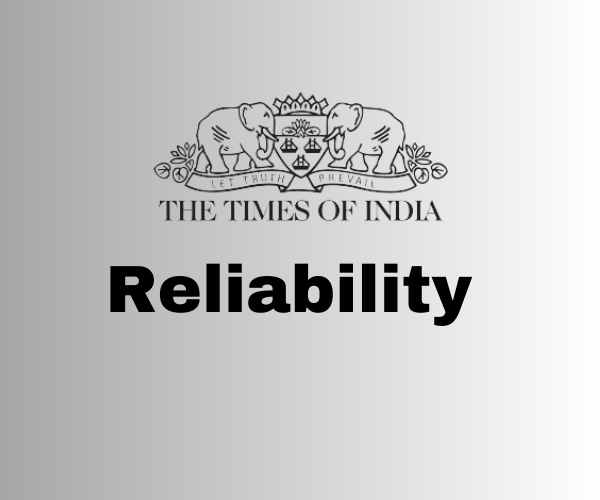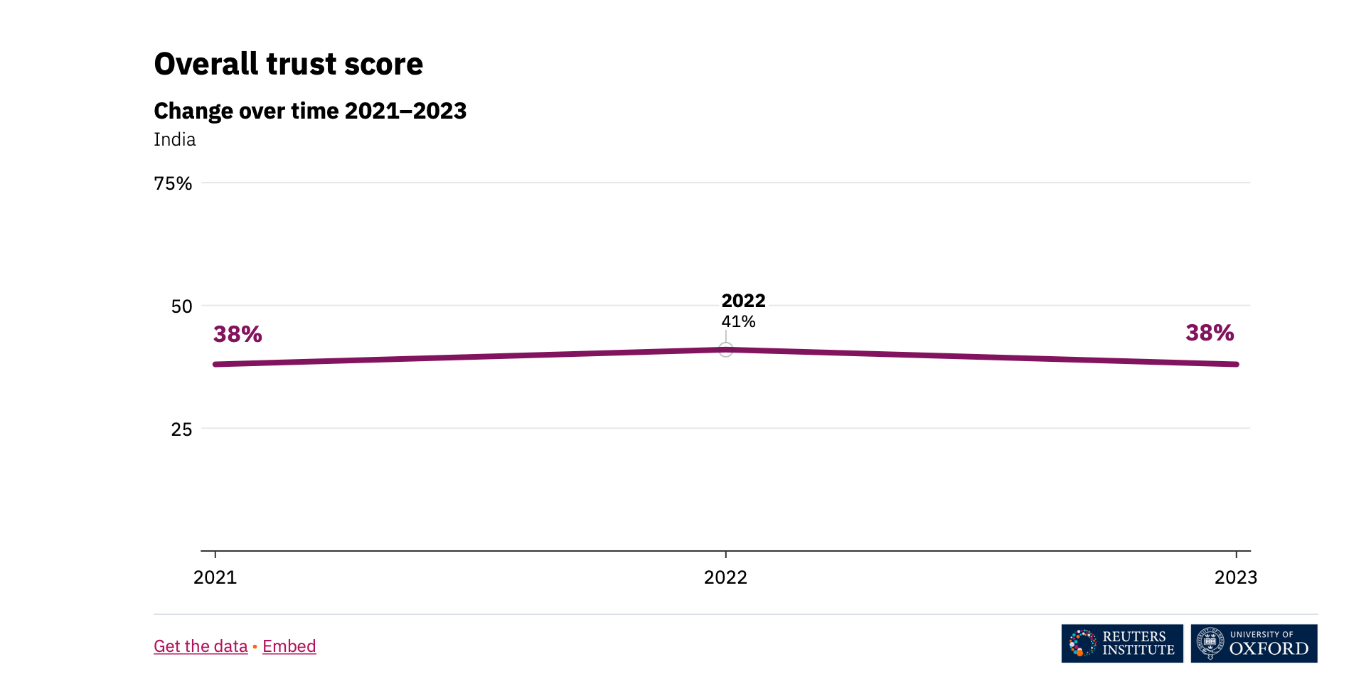
According to Dergipark Intermedia International Journal, in an online survey conducted among 3,183 online news consumers of India:
“The Times of India is the most readable (43.5%) online news source among the respondents, followed by Social Media (38%).”
With The Times of India being perhaps the most popular publication in the country, it is important to question how reliable of a source it may be. In the age of social media, news is published at speeds and capacities never seen before. In the case of the massive population of India, more people than ever are receiving their information and putting their trust and confidence in this publication.
What do the people of India think about the news they are consuming? Many opinions on Indian news sit quite low on the totem pole of trust. It seems the country believes the consolidation of Indian news companies, and the government funding used to keep them afloat, puts into question the reliability of Indian news as a whole. See below, a graph made by the Reuters Institute on the levels of trust Indian people have in their media coverage:

Reuters, Indian Citizens Trust in Media. 2023. https://reutersinstitute.politics.ox.ac.uk/digital-news-report/2023/india
Clearly, the reliability of news in India is not well perceived within the country. At its peak in 2022, Indian news was perceived as unreliable by more than half of the country. Why may this be the case? Is the Times of India a perpetrator of this epidemic of distrust? In this article, let us analyze the reliability of the publication itself, and reach a conclusion as to whether the Times of India is a reflection of the state of Indian journalism.
How Does The Times of India Fare in its Reliability?
The political reliability index developed by Biasly objectively assesses news organizations’ accuracy and trustworthiness. The Times of India’s overall Reliability Score has been rated as ‘Fair’ by Biasly. This rating is a weighted average of two distinct scores: the Fact Analysis Score and the Source Analysis Score, each evaluating separate components of The Times of India’s Reliability. When computing the Average Reliability of the article the Fact Analysis score is more heavily weighted. These ratings are as follows in the next two paragraphs:
The Times of India’s Fact Analysis Score is ‘Fair,’ which suggests readers can trust some of The Times of India’s content online. The Fact Analysis score focuses more on the accuracy of claims, facts, and sources presented in the article and any hints of selection and omission bias, which we will discuss further in the article.
The Times of India’s Source Analysis Score is ‘Fair,’ which suggests readers can trust some of the sources, links, and quotes provided by the news source. This score, which is based on A.I., focuses on assessing the quality of sources and quotes used including their number, lengths, uniqueness, and diversity.
However, since these scores are based on percentages and averages, individual articles could be more or less trustworthy depending on the context, author, and other factors. Our findings show that The Times of India’s reliability is mostly but not all factual because they have retracted several stories in the past or had pieces that were not factual.
Let us analyze the supporting data for The Times of India’s rankings and discuss what to watch out for while searching for trustworthy news sources.
The Times of India Accuracy and Reliability
A mixed reaction on the reliability likely implies that the publication employs many different writers, all with different approaches to the articles they are releasing. When compared to their bias score, it seems as though the numbers are similar enough to make this conclusion. A medium level of bias, on par with a medium level of reliability.
As a way to assess accuracy and reliability, it is important to take a look at the choices of articles that The Times of India is publishing. A sure way of understanding the trustworthiness of a publication is by exploring its selection and omission bias. This refers to the stories writers choose to write, and the facts writers may choose to omit.
While the bias rating previously mentioned is an important reflection, its position in the middle ground of rating signals that a deeper look and understanding of specific articles is necessary. While it is informative to look at percentiles, nothing will showcase bias and reliability more than a look at the writings themselves.
This sort of analysis works well in any sort of publication. See Biasly’s analysis on Fox News. Biasly rates Fox News as a “Very Conservative” news publication. Reliability-wise, Fox News is rated at 43% reliable.
However, if one were to look at some of the articles analyzed, it becomes clear that these ratings are only applicable to some articles by Fox News. See Greg Gutfeld’s article published on the Fox News website titled Social Justice Could Get You Murdered. This Op-Ed piece is rated as a “Center” bias, implying it does not necessarily lean one way or the other. This is clearly not reflective of the general bias rating given by Biasly.
Similarly, take a look at another article assessed by Biasly. Thomas Barrabi writes an informative piece titled, Biden fires Social Security Commissioner Andrew Saul. Biasly rates this article with 92% accuracy, once again a difference in the average rating.
The point here is that the general bias rating cannot be applied to every article released by a publication, therefore it is important for readers to do their own research into bias and inaccuracy that they may find as they consume news.
Selection and Omission Bias
Let us now take a look at how this sort of situation occurs when analyzing The Times of India. As stated previously, Biasly gives the publication a “Somewhat Conservative” rating in terms of bias, and a moderate rating on reliability and accuracy. However, analysis of specific articles often shows different results.
An article by Elsamarie D’silva titled What Kamala Harris’s Feat Means For Aspiring Women Leaders is rated by Biasly as a relatively liberal bias. Of course this bias does not necessarily match up with either of the scores given by Biasly AI ranking, or Biasly human analysts. The score is also given a “Good” reliability rating, exceeding both of the general reliability ratings given.
D’silva’s liberal tendency can be shown by giving credit to the first woman of color, Vice President Kamala Harris. D’silva explores concepts of identity politics generally avoided by conservative writers. She writes:
“Why is it important to have more women in Parliament or leadership positions? Women comprise 50% of the population in most countries and the democratic elected leadership should reflect that representation. Women bring different strengths to a team and this is reflected in the successful handling of the coronavirus pandemic around the world. The countries that have done exceedingly well have one thing in common – female leaders.”
The reliability ranking is interesting here, as it is given a 60%. While the article is a majority opinion piece, perhaps even simply an inspirational speech, D’silva omits massive aspects of Harris’ career. While speaking praises on Harris’ benefit to people of color in America, D’silva does not reference Harris’ conservative positions on crime as an attorney general, and the mass incarceration of minority groups her position resulted in. This omission of information shows that D’silva wanted to make a potentially biased point in her article, and therefore ultimately lacked in reliability to do so.
Quality and Sources of Facts Used
As stated previously, the population of India tends to have a low level of trust in their media sources as a whole, however regardless of this The Times of India is widely regarded as the most trustworthy English news source in the country. An overview of the facts and quotes stated in the article will give a better understanding of the quality of the facts provided within their articles. Let’s take a look at an article titled I-T Quizzes Vadra in Bikaner Land Case. Throughout the article there are no direct quotes, yet there are four different references to unnamed sources providing what is presented as undisputed facts throughout the article.
The article contains no source links aside from ones that lead readers to different articles also published by the Times of India. All in all, this article provides a low quality of sources, as there are essentially no sources to be rated.
This sort of lack of sourcing is very common throughout articles across the publication. While fact checking does seem to corroborate most statements made within these articles, it is dangerous and of low quality to have so many references to unnamed sources as the publication does. While the publication does provide a good amount of statistical fact and information, they tend to lack sources for these as well.
Returning to the article above, What Kamala Harris’s Feat Means For Aspiring Women Leaders, the same issue can be noted. Throughout the article there are 9 separate references to statistical information meant to support the points made by D’silva, yet not one of them is sourced.
This consistent habit of refusing to name sources ultimately lessens the credibility of the publication massively. The source quality is essentially as low as possible, as there is rarely referenced sources to analyze.
Analysis of The Times of India Opinion Pieces
Opinion pieces are likely some of the most-read articles in journalism. While they are not always trustworthy, as they are subjective, they are often more riveting reads than general information articles. This results in a great necessity for analyzing bias and reliability within them, instead of consuming and working off of the (possibly uninformed) opinions of others.
On the topic of the sort of dangers uninformed opinion pieces may pose, Dame Magazine’s Parker Molloy writes an article titled Opinion Journalism Is Broken. Molloy states:
“We live in a confusing world where fact and fiction blend together, and what should be sources of clarity—i.e. newspapers— may actually be functioning as sources of confusion, making them ripe for bad actors looking to exploit the aforementioned vulnerabilities in the system to push dubious information in service of a political agenda. This is, quite obviously, a problem on its own. If the goal of newspapers is to inform the public, yet they publish materials that mislead it, aren’t they undermining themselves?”
With all of this in mind, let’s take a look at the opinion pieces posted by The Times of India. See Paul Kruger’s opinion piece, Why Biden Will Need to Spend Big. This opinion piece outlines Kruger’s opinion on the ways in which the Biden administration should approach the economy post covid. The introduction immediately paints the article as an opinion piece, as Kruger begins by saying:
“What should Joe Biden’s economic policy be if he wins (and Democrats take the Senate, so that he can actually pass legislation)? I’m pretty sure I know what his economists think he should do, but I’m not equally sure that everyone on his political team fully gets it.”
Kruger’s opinion piece is rated by Biasly as moderately liberal and 40% reliable. This reliability rating is likely attributed to a similar factor seen in D’silva’s piece. While Kruger makes many claims throughout the article, he doesn’t seem to substantiate them in any way. An article on the economy cannot be based on ideas alone, as this does not do justice in informing readers about such complex topics.
In both aforementioned articles, it is interesting to address what these writers choose to omit. Throughout D’Silva’s article, we see a lack of information on the political history of Kamala Harris. There is next to no exploration into her credibility aside from her identity. In Krugers article, there is an omission of facts regarding the economy, perhaps because fact would render his argument illegitimate.
Omission and selective writing is one of the most important things to keep in mind when analyzing the reliability of an article. Often it is more important to make note of what one does not say, as opposed to what they do.
So, Is The Times of India Reliable?
Ultimately, I would say that the Biasly rating of a medium-level reliability is relatively accurate. A look through the articles on The Times of India online publication shows extensive amounts of articles filled with statistics and facts, as well as opinion articles that do not show as much. The reliability of the Times of India averages similarly to their bias, reflecting the likely fact that a less biased publication would be able to provide less inaccurate information.


























